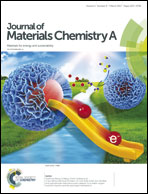Influence of phase transitions and defect associates on the oxygen migration in the ion conductor Na1/2Bi1/2TiO3†
Abstract
Doped or non-stoichiometric Na1/2Bi1/2TiO3 (NBT) exhibits an ion conductivity comparable to yttria stabilized zirconia (YSZ) [M. Li et al., Nat. Mater., 2014, 13, 31–35], with a temperature dependent activation energy. To understand the origin of this temperature dependence we calculated oxygen vacancy migration barriers for three different phases of NBT by means of nudged elastic band calculations within a density functional theory (DFT) approach. We find that for structures with rock-salt ordered A-cations (111-order), the room temperature rhombohedral phase, the intermediate orthorhombic phase and the high temperature tetragonal phase show different migration barriers, decreasing from the rhombohedral to the tetragonal phase. The change in migration barriers from the rhombohedral to tetragonal phase is, however, not large enough to explain the experimentally observed difference. At lower temperatures, the association of oxygen vacancies with either Mg dopants or Bi vacancies increases the activation energy for the migration of oxygen vacancies. Thus, a combination of phase dependent migration barriers and defect association can explain the temperature dependent change in activation energy. Further, when a layered A-cation order (001-order) is present, the oxygen vacancies prefer to be located within the Bi-layer and a fast diffusion along the Bi-layer can occur. Large migration barriers are due to electronic defect states of the migrating oxygen ion.

- This article is part of the themed collection: 2017 Journal of Materials Chemistry A HOT Papers


 Please wait while we load your content...
Please wait while we load your content...